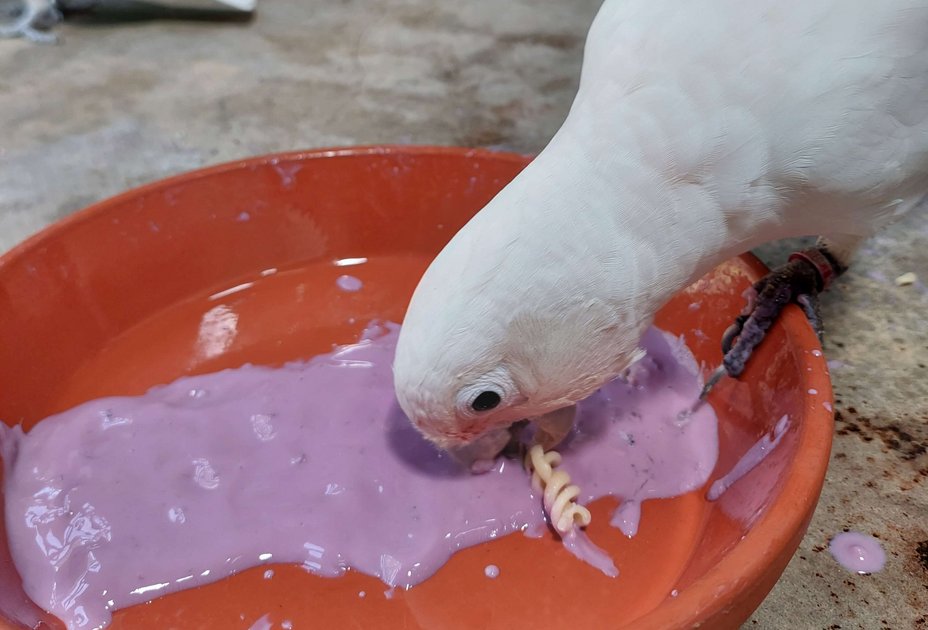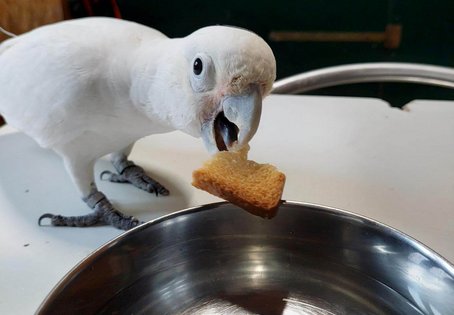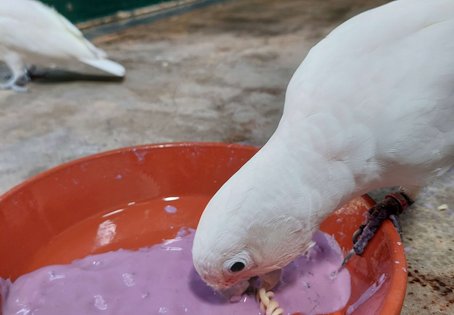- Home /
- University /
- Infoservice /
- Press Releases /
- Cockatoos’ kitchen: Goffin’s cockatoos add flavour to their food and change its texture
Research
Cockatoos’ kitchen: Goffin’s cockatoos add flavour to their food and change its texture
As humans, we put a lot of effort and dedication in preparing raw foods into elaborate meals. Many people even spent considerable money on being served the latest and greatest culinary inventions. Preparing food has undoubtably become a crucial part of our daily activities and culture. But did you know that some animals also prepare their food? Of course, not in a kitchen with a stove, but in a recent study cognitive biologists from Messerli Research Institute at the University of Veterinary Medicine in Vienna (Vetmeduni) discovered that some cockatoos like to adjust both the texture and taste of their food.

It all started with three Goffin cockatoos (Pipin, Muki and Kiwi) kept in a social group in a large aviary in Austria that placed their rusk into water and retrieved it before eating it. “We saw this curious behaviour and were interested in why the cockatoos were doing this,” says Jeroen Zewald, the PhD student who conducted this research. “In general, innovations of new feeding styles are seen as intelligent behaviour, so we were curious whether this also applied to our cockatoos.” The researchers systematically analysed the behaviours of the animals during lunchtime in order to unravel the function of this behaviour. “There are several possible reasons for animals to dunk food prior to consumption. They can wash their food in water, soak it, flavour it, or use the food as a sponge to transport the water to their chicks,” the researchers said. They showed that the cockatoos carefully placed the rusk in the water and let it soak for an average of 20 seconds, occasionally turning it before they started eating. The cockatoos only dunked dry rusk and no other food types, placed it into fresh water which did not add taste, and they did not have chicks at the time. So, the researchers were able to conclude that the most likely function of the behaviour was to change the texture of the rusk by soaking it, much like we would dip a biscuit into our morning tea.
But it did not stop there. “To our great surprise, we later saw that the cockatoos also dragged pasta in blueberry soy yogurt. Possibly to add flavour to their food, just like people dip their chips in ketchup,” Zewald added. “The seasoning of food has only once been described until now.” Zewald referred to the only existing study from the 1960s in which Japanese macaques dipped potatoes in salt water, possibly for the extra flavour. Nevertheless, the function of the behaviour in macaques was never experimentally investigated.
By giving the cockatoos a choice between unflavoured and blueberry soy yoghurt, the researchers were able to show that the cockatoos really seem to do dip for the added flavour. The cockatoos rarely dipped their food in this tasteless soy yoghurt. “Not all cockatoos in our group, however, showed this dipping of their food,” says Zewald. “That probably means this is a new invention by the cockatoos that is not part of their normal behaviour.” Interestingly, the nature of the behaviour was strikingly different than the dipping in water with rusk. While the former was carefully placed in the water, the pasta was violently dragged and rolled to get yogurt all over. Moreover the animals ate the parts of noodle with soy yogurt on it first and often re-dipped when there was no more soy yogurt on it. Much like a naughty kid overdoing it with their ketchup helpings.
Furthermore, dipping food in fluids has not yet been observed in their natural habitat in Indonesia. “These cockatoos are known for using tools in innovative ways in the wild. For example, they make sharp wooden objects from tree branches to open hard-shelled fruits. These kinds of discoveries in tool use and food preparation show us how flexible, innovative, and curious these animals are.” says co-investigator Alice Auersperg, professor at the University of Veterinary Medicine Vienna and author of the book ‘Der Erfinder Geist der Tiere’. “I hope that becoming aware of their intelligence will foster our respect of these creatures rather than a desire to own them as pets. Often, keep them as pets may not be a good idea as these cockatoos are much like hyperactive children with a Swiss army knife for a beak, which they use in many different ways to cause a lot of damage. Also to themselves if they do not receive hours of entertainment every day and live a sufficient enriched environment.”
Yet, research on these cockatoos contributes a lot to our knowledge of how animals can adapt and deal with novel problems in their environment. Auersperg: “Although we normally challenge our cockatoos by giving them a problem and then observing how they solve it, this time the cockatoos showed that they had discovered solutions to problems that we had not even thought of. Apparently, their food wasn't tasty enough.” This study shows that humans are not the only animals with culinary preferences. And to the question if Zewald himself would like blueberry soy yoghurt with his pasta, he replied “I prefer Pomodoro sauce”.
The article "Innovative flavouring behaviour in Goffin cockatoos" by Jeroen Zewald andAlice Auersperg was published in Current Biology.
Scientific article
Further informations:
Dunking rusk: innovative food soaking behaviour in Goffin's cockatoos (Cacatua goffiniana)
Der Erfindergeist der Tiere
Scientific contacts:
Jeroen Zewald, MSc.
Messerli Forschungsinstitut (MFI)/Goffin Lab
Veterinärmedizinische Universität Wien (Vetmeduni)
Jeroen.Zewald@vetmeduni.ac.at
Assoz.-Prof. Priv.-Doz. Dr.rer.nat. Alice Auersperg
Messerli Forschungsinstitut (MFI)/Goffin Lab
Veterinärmedizinische Universität Wien (Vetmeduni)
Alice.Auersperg@vetmeduni.ac.at
Photos: Messerli Forschungsinstitut/Vetmeduni





